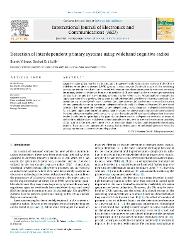| dc.contributor.author | Yılmaz, Burak | |
| dc.contributor.author | Erküçük, Serhat | |
| dc.date.accessioned | 2019-06-27T08:03:51Z | |
| dc.date.available | 2019-06-27T08:03:51Z | |
| dc.date.issued | 2013 | |
| dc.identifier.issn | 1434-8411 | en_US |
| dc.identifier.issn | 1618-0399 | en_US |
| dc.identifier.uri | https://hdl.handle.net/20.500.12469/851 | |
| dc.identifier.uri | https://doi.org/10.1016/j.aeue.2013.05.003 | |
| dc.description.abstract | Cognitive radios (CRs) may be sharing multiple frequency bands with primary systems if the CR is a wideband or an ultra wideband (UWB) system. In that case the CR should ensure all the coexisting primary systems in these bands are detected before it can start data transmission. In this work we study the primary system detection performance of a wideband CR assuming that there are multiple coexisting primary systems and that these primary systems may be jointly active. Accordingly we consider the implementation of energy detection scheme in multiple bands followed by two detection methods: (i) a maximum-a-posteriori (MAP) based detection (i.e. joint detection) that takes into account the statistics of simultaneously operating systems in independent bands and (ii) a Neyman-Pearson (NP) test based detection that optimizes the threshold values independently in each band (i.e. independent detection). For a simpler implementation of the independent detection we show that the threshold values obtained from joint detection can be used in order to achieve the optimum NP test based independent detection results. In addition to quantifying the gain of joint detection over independent detection in terms of probabilities of false alarm and detection for practical scenarios we also present the operation capability of CRs in terms of the fractions of time the CR can access the channel without interfering with the primary systems. The results are important for the practical implementation of multiband detection when the primary systems are known to be interdependent. (C) 2013 Elsevier GmbH. All rights reserved. | en_US] |
| dc.language.iso | eng | en_US |
| dc.publisher | Elsevier GMBH Urban & Fischer Verlag | en_US |
| dc.rights | info:eu-repo/semantics/openAccess | en_US |
| dc.subject | Cognitive radios | en_US |
| dc.subject | Ultra wideband (UWB) systems | en_US |
| dc.subject | Detect-and-avoid (DAA) | en_US |
| dc.subject | Wideband spectrum sensing | en_US |
| dc.subject | Energy detection | en_US |
| dc.title | Detection of interdependent primary systems using wideband cognitive radios | en_US |
| dc.type | article | en_US |
| dc.identifier.startpage | 926 | en_US |
| dc.identifier.endpage | 936 | |
| dc.relation.journal | AEU-International Journal Of Electronics And Communications | en_US |
| dc.identifier.issue | 11 | |
| dc.identifier.volume | 67 | en_US |
| dc.department | Fakülteler, Mühendislik ve Doğa Bilimleri Fakültesi, Elektrik-Elektronik Mühendisliği Bölümü | en_US |
| dc.identifier.wos | WOS:000324976400003 | en_US |
| dc.identifier.doi | 10.1016/j.aeue.2013.05.003 | en_US |
| dc.identifier.scopus | 2-s2.0-84883741583 | en_US |
| dc.institutionauthor | Erküçük, Serhat | en_US |
| dc.relation.publicationcategory | Makale - Uluslararası Hakemli Dergi - Kurum Öğretim Elemanı | en_US |
















